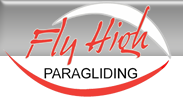 |
||||
 |
||||
 |
||||
P2 Novice Rating - Required Witnessed Tasks
Logged Requirements
- Attends a minimum of 8 hours of ground school.
- 25 flights. At the discretion of any paragliding instructor or special observer, powered paragliding flights can be used to fulfill this requirement. Use of a powered paraglider to demonstrate the required witnessed tasks is allowed, as long as the engine is stopped at no lower than 200 feet AGL and remains off.
- 5 flying days.
Demonstrated Skills and Knowledge
- Demonstrates layout and preflight of the canopy, harness, and backup reserve parachute.
- Gives a reliable analysis of general conditions of the site and self, and a flight plan including flight path, areas to avoid in relation to the wind flow, and obstacles to stay clear of.
- Demonstrates 5 consecutive forward inflations with a visual check of the canopy each time.
- Demonstrates 5 consecutive controlled reverse inflations with proper surge dampening.
- Demonstrates controlled kiting of a glider overhead for 2 minutes in a steady wind.
- Demonstrates 2 clean, smooth reverse inflations/reversals prior to launch.
- With each flight, demonstrates a method of establishing that the pilot is properly connected to the glider, with cleared lines and risers just prior to inflation.
- Demonstrates 2 successful, aggressive, confident inflations/launches, where the wind is at least 15° cross to straight up the hill in wind not exceeding 5 m.p.h.
- Demonstrates 2 no-wind (0-5 m.p.h.) inflations/launches.
- Demonstrate how to brief and instruct a ground crew and explain when an assisted launch is necessary.
- Demonstrates 2 high-wind (10-15 m.p.h.) inflations/launches.
- Demonstrates flight with smooth variation in airspeed, from above minimum sink to fast flight, while maintaining a heading.
- Demonstrates flight showing the ability to comfortably and precisely slow the glider to minimum sink and smoothly increase to normal airspeed while maintaining a heading. The pilot should not slow the glider to near the stall speed.
- Demonstrates flight(s) along a planned path alternating 'S' turns of at least 90° change in heading. Flight heading need not exceed 45° from straight into the wind. Turns must be smooth with controlled airspeed, ending in safe, stand up landings on a heading.
- Demonstrates 360-degree turns in both directions, and at various speeds and bank angles.
- Demonstrates hands-off flying, one handed flying skills, weight-shift turns, and rear-riser turns.
- Demonstrates symmetric and asymmetric tip folds for increased descent rate.
- Demonstrates the ability to judge and allow for proper clearance from a ridge and other aircraft.
- Demonstrates 5 landings within 25' of a target, safe, smooth, on the feet and into the wind. The target must be sufficiently close to launch such that turns are required to set up an approach and avoid over-flying the target. The target should be at least 100' below the launch point.
- Explains proper strong wind landing procedures and how to keep from being dragged back.
- Explains correct canopy maintenance.
- Explains how to lengthen and shorten the flight path.
- Explains the right of way traffic rules.
- Explains the use of a speedbar/accelerating system.
- Demonstrates reserve deployment while hanging in a harness in simulated turbulence or malfunction conditions.
- Gives a thorough verbal demonstration of knowledge of how to:
a. Maintain directional control during and correct for an asymmetric wing fold of 25% of the wing span.
b. Fly at minimum sink while precluding any chance of inadvertent stall or spin.
c. Increase descent rate and/or forward speed. - Demonstrates proper and effective PLF technique.
- Must pass the USHPA Novice Paragliding written exam.
- Must agree to all the provisions of the USHPA standard waiver and assumption of risk agreement for the Novice rating and deliver an original signed copy to the USHPA office.
- Acknowledges and understands the need to become familiar with site-specific restrictions and launch or landing access limits, consistent with preservation of flying privileges at a site.
P2 Recommended Operating Limitations for Novice Paragliding Pilots
- Should exceed these limitations only after thoroughly mastering all required tasks, and after acquiring a full understanding of the potential problems and dangers involved in exceeding these limitations.
- Maximum base wind of 12 m.p.h.
- Maximum peak gusts to 15 m.p.h.
- Maximum gust rate of 5 m.p.h. in 5 seconds.
- Should not fly in thermal lift where peak climb rates exceed 200 fpm.
- If foot launching, should launch only on slopes steeper than 4:1, where the wind is within 25° of being straight up the slope.
- Visual contact with the landing zone.
- Avoid application of either brake beyond 2/3 of the way from slack to stall position.
- Limit turns to 30° of bank, limit speed in turns to 1.5 times the straight line, brakes off, cruise speed, and smoothly exit any spiral turn which shows a tendency to steepen or accelerate.
- Should fly a canopy recommended by the manufacturer as suitable for Beginner to Intermediate pilots.